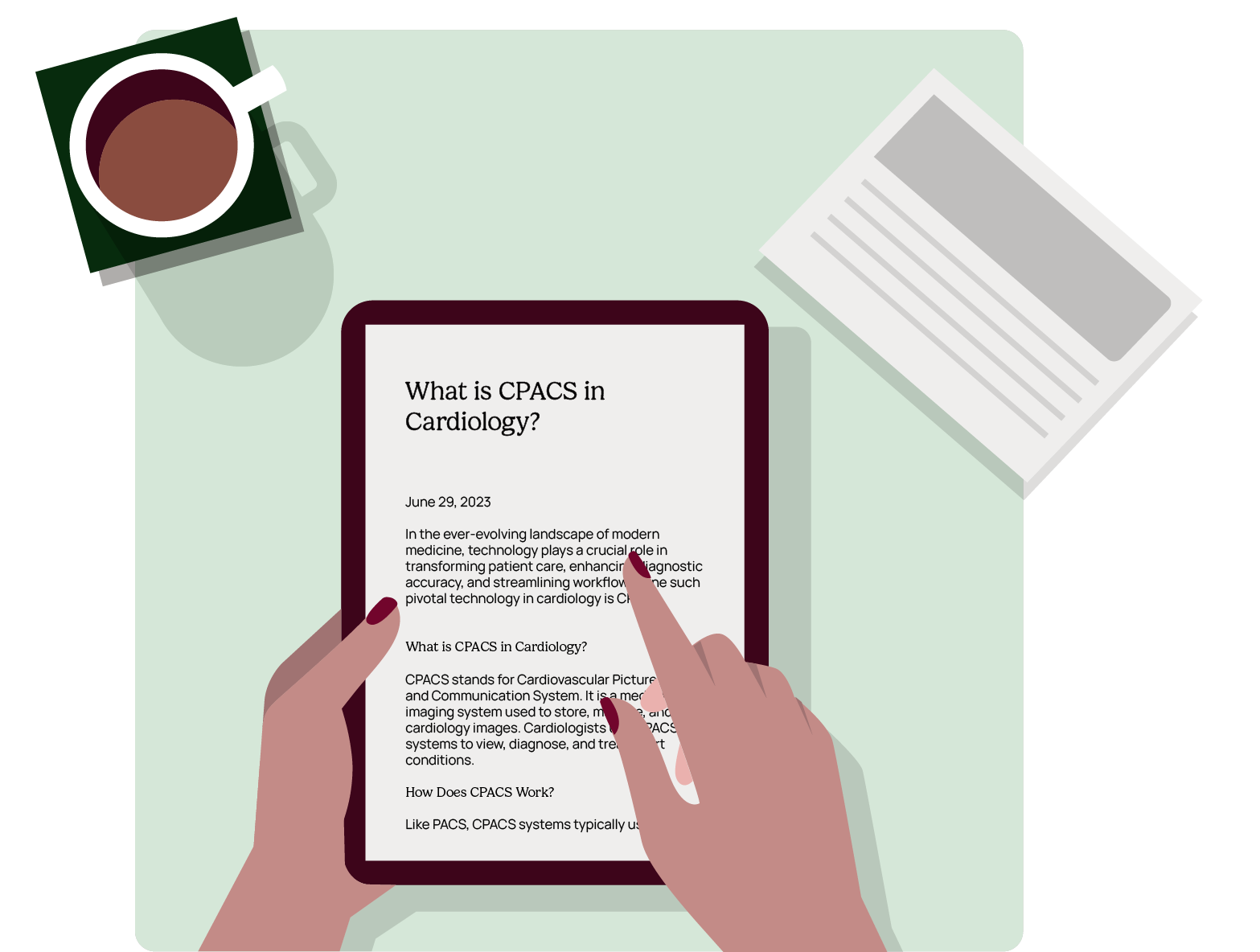June 29, 2023
In the ever-evolving landscape of modern medicine, technology plays a crucial role in transforming patient care, enhancing diagnostic accuracy, and streamlining workflows. One such pivotal technology in cardiology is CPACS.
What is CPACS in Cardiology?
CPACS stands for Cardiovascular Picture Archive and Communication System. It is a medical imaging system used to store, manage, and share cardiology images. Cardiologists use CPACS systems to view, diagnose, and treat heart conditions.
How Does CPACS Work?
Like PACS, CPACS systems typically use DICOM (Digital Imaging and Communications in Medicine) standards to store and transmit images. DICOM is a standard that allows healthcare providers to exchange medical images and related information electronically. This allows cardiologists to view images from other healthcare providers, such as radiologists or cardiac surgeons.
CPACS systems can be integrated with other healthcare information systems, such as electronic health records (EHRs). This integration allows cardiologists to view cardiology images alongside other patient information, such as demographics, clinical notes, and test results.
Understanding CPACS
CPACS is a specialized healthcare information technology system designed explicitly for cardiology departments. It provides efficient storage, access, and management of cardiology images and diagnostic reports, thus playing an integral role in the comprehensive treatment of cardiovascular diseases.
Delving Deeper into CPACS
The heart of CPACS lies in its ability to collect, manage, and store all cardiology-related images. These include images from various modalities such as echocardiography, nuclear cardiology, vascular ultrasound, electrocardiography (ECG), and others. By digitizing and storing these images in a centralized system, CPACS reduces the need for physical storage spaces and drastically enhances data accessibility.
CPACS integrates seamlessly with different imaging modalities within a cardiology department. This integration allows for smooth data communication and exchange between modalities, streamlining workflow, and promoting efficiency. For instance, an image captured by an echocardiogram can be instantly available for review on the CPACS system.
Another significant feature of CPACS is its ability to manage associated diagnostic reports. These reports are readily accessible within the system, promoting swift clinical decision-making and enhancing patient care.
Improving Patient Care
Here is how CPACS systems can help to improve patient care:
- Improved diagnosis: CPACS systems can help cardiologists to diagnose heart conditions more accurately by providing them with access to a wider range of images.
- Improved treatment: CPACS systems can help cardiologists to develop more effective treatment plans for patients with heart conditions by providing them with access to images that show the progression of the condition over time.
- Improved communication: CPACS systems can help cardiologists to communicate more effectively with other healthcare providers by providing them with access to images that can be shared electronically.
Usage of CPACS in the Diagnosis and Treatment of Heart Diseases
CPACS systems are used in various ways to diagnose and treat heart diseases. Some of the most common uses of CPACS systems include:
Echocardiography is a type of ultrasound used to image the heart. CPACS systems store and manage echocardiogram images, which cardiologists can use to diagnose heart conditions such as heart failure, coronary artery disease, and congenital heart defects.
Cardiac MRI is a type of magnetic resonance imaging used to image the heart. CPACS systems store and manage cardiac MRI images, which cardiologists can use to diagnose heart conditions such as heart failure, coronary artery disease, and cardiomyopathy.
Cardiac CT is a type of computed tomography used to image the heart. CPACS systems store and manage cardiac CT images, which cardiologists can use to diagnose heart conditions such as heart failure, coronary artery disease, and aortic aneurysms.
CPACS: A Catalyst for Improved Collaboration and Patient Outcomes
The benefits of CPACS go beyond storage and integration. It’s an influential tool for promoting collaboration among healthcare professionals. Given that CPACS systems can usually be accessed from multiple workstations, different specialists can review the same patient’s images simultaneously. This fosters a collaborative approach, expedites diagnosis, and hastens the treatment process.
Consider a patient presenting with acute chest pain in the emergency department. With CPACS, the ECG taken upon arrival is immediately available for review by the attending cardiologist, even if they are physically distant. They can assess the situation rapidly and advise the most appropriate treatment plan, potentially saving crucial minutes in cases of acute myocardial infarction.
Furthermore, the comprehensive approach of CPACS aids in patient management by facilitating more informed decision-making, leading to better patient outcomes. With all images and diagnostic reports in one place, doctors can more effectively track a patient’s progress, adjust treatment plans as needed, and predict outcomes more accurately.
Security and Compliance: A Cornerstone of CPACS
As with any healthcare information system, patient privacy and data security are paramount in CPACS. Adhering to regulations such as the Health Insurance Portability and Accountability Act (HIPAA) in the United States, CPACS ensures that patient data is handled securely and confidentially.
CPACS systems are a valuable tool for cardiologists and other healthcare providers who care for patients with heart conditions. By storing, managing, and sharing cardiology images, CPACS systems can help to improve the quality of care for patients and reduce the cost of healthcare. With all the vast benefits the system offers, technology evolves and continuously pushes forward. The healthcare industry is transitioning from CPACS to CVIS (Cardiovascular Information System.) Here is a comprehensive guide to understanding why. Staying abreast of the latest medical technological advances ultimately helps improve the quality of patient care.
Schedule a demo of HealthView CardioPACS today and revolutionize your cardiovascular image management with the only fully integrated solution that empowers physicians to review images and patient data simultaneously.





